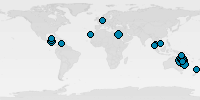3.72

Diving at dive site Panorama Reef or Abu Alama
| Name Dive Site: | Panorama Reef |
| Depth: | 3-40m (9-131ft) |
| Visibility: | 20-40m (65-131ft) |
| Accessibility: | Boat, Live-aboard |
| Inserted/Added by: | lars, © Author: Lars Hemel |
| Rated: | Rated 2.4, 5 votes |
| Specifications: |      |
Send us your images for this dive site[Add Image][Add Movie]
Panorama Reef is one of the biggest oval shaped reefs near Safaga and has several different diveplans. Drift diving is common because of the big current that often comes from the north. Start this dive by taking a good look at the most northern point for pelagic and big fish that are attracted by the currents, but this area is also home to many purple soft corals. Then the dive continues by drifting southward along the east or west side of the reef. If the skipper doesn't feel like making a drift dive you often dive at the southern plateau where you can see an excellent and huge anemone field which is often named Anemone City and has over 40 rose anemones and hundreds of clownfish. Keep an eye out for the giant orange colored anemone.
The main attraction of the reef is obviously the steep walls that disappear into the deep with depths of more than 200 meters. Cavelets and overhangs are the second best thing you should look at, because they are teeming with life. Coral life is great with many types of soft coral and hard coral at all sides of the reef. The amount of different species of fish is mind-blowing with reef fish such as schools of anthias, parrotfish, needlefish, lionfish, scorpion fish and all the other moon and banner fishes. Bigger species such as whitetips, barracuda, jacks, the occasional hammerheads and manta rays can also be seen at times, more often in the northern section. Also tuna and trevelly can be seen in the blue, so keep your eyes open and don't only look at the astonishing wall.
[Add Message]Messages from readers:
[Add Divelog]Divelogs from members:
